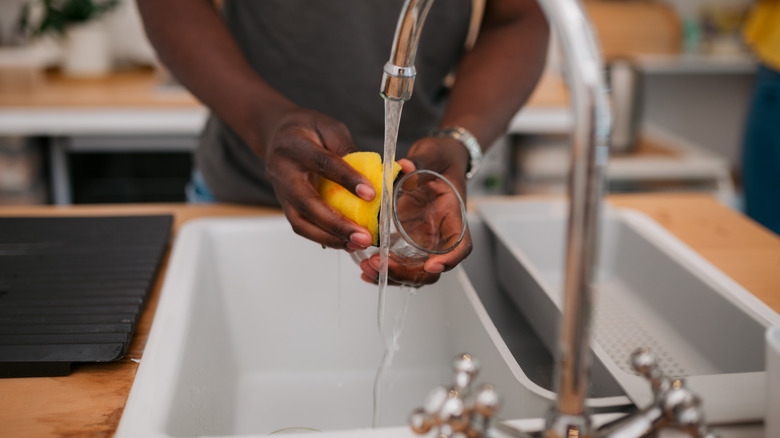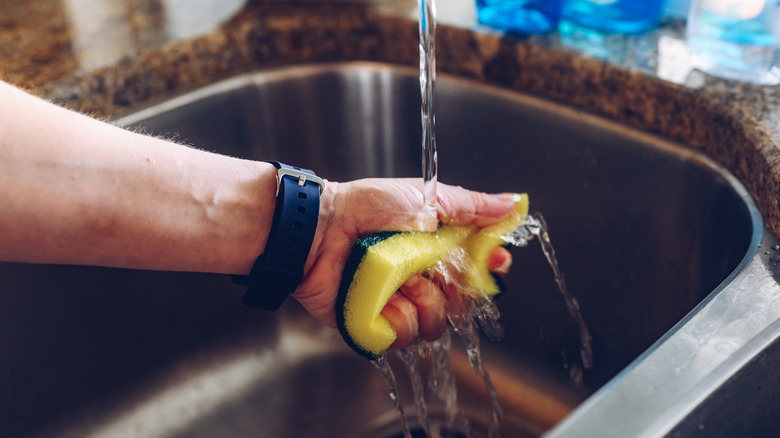The Essential Oil That'll Help Refresh Your Dirty Sponge
One of the filthiest places in your home is surprisingly not in the bathroom. Your kitchen sponge, however, has 45 billion bacteria within each square centimeter, a density so high that it's seemingly only challenged by that of the human gut (via NPR). While bacteria in the gut are necessary for breaking down food during digestion, the bacteria on your sponge do not aid in cleaning your food-crusted dishes. These bacteria on kitchen sponges pose a significant health risk due to their ability to harbor and multiply harmful microorganisms. Sponges create a moist and porous environment, ideal for bacterial growth. Pathogens like Salmonella and E. coli can thrive, leading to cross-contamination during dishwashing. Additionally, kitchen sponges come into contact with various surfaces, easily transferring these harmful bacteria to utensils and countertops. Nevertheless, one way you can breathe some life back into a dirty sponge is by using tea tree oil.
Tea tree oil, an essential oil derived from steaming the leaves of an Australian tea tree, can help to reinvigorate a grimy kitchen sponge. This natural oil boasts antimicrobial properties, tackling the bacteria, viruses, and fungi that love to call sponges home. Not only will a dash of tea tree oil kick bacteria to the curb, but it will also leave behind a refreshing scent, helping to mask unpleasant odors that can develop in frequently used sponges. While it's not the fountain of youth, tea tree oil can help to extend the life of your kitchen sponge.
How to use tea tree oil on your sponge
Tea tree oil is a natural and effective way to refresh your kitchen sponge. In order to do so, mix 10 drops of tea tree oil per 1 ounce of water in a clean container. Submerge the dirty sponge in the tea tree oil solution. Make sure the entire sponge is fully saturated. Allow it to soak for at least 10 minutes. After soaking, remove the sponge from the solution and rinse it thoroughly with warm water. Squeeze out any excess water and oil. This step is essential to remove any remaining oil residue and prevent it from transferring to your dishes. Place the sponge in a well-ventilated area to air dry completely. Avoid storing it in a damp or enclosed space, as this can promote bacterial growth.
This method of using tea tree oil to refresh your sponge is a good idea when it starts to develop an odor or shows signs of discoloration. Both of these changes usually indicate bacterial growth. It is recommended to refresh your sponge with tea tree oil at least once a week to maintain cleanliness and prevent the buildup of harmful bacteria. However, if your sponge is heavily soiled or has been used to clean raw meat or other high-risk foods, it is best to replace it instead of trying to refresh it with tea tree oil. These situations can introduce harmful pathogens that may not be effectively eliminated by tea tree oil alone.
Drawbacks of this method
Although tea tree oil is a popular natural remedy known for its antimicrobial properties, it's important to understand that tea tree oil alone may not be enough to completely sanitize a sponge. While tea tree oil is effective against many bacteria and fungi, it may not eliminate all types of harmful microorganisms found on kitchen sponges.
Using a clean sponge is necessary for maintaining proper hygiene in the kitchen. In addition to using a tea tree oil solution to aid in killing harmful bacteria in your sponge, there are other steps you can take to bolster this effect. Boiling or microwaving a damp sponge for one to two minutes on high power can also help to kill bacteria living in your sponge. However, caution must be exercised to prevent the sponge from catching fire or melting in addition to causing burns. Alternatively, soaking the sponge in a mixture of 1 teaspoon of bleach with 1 quart of water for a minute can help eliminate bacteria. Thorough rinsing is necessary to remove any residual bleach that should not be consumed.
Nevertheless, if your kitchen sponge is heavily soiled, has an unpleasant odor, or has been used to clean raw meat or other high-risk foods, it is best to replace it rather than relying solely on tea tree oil or other cleaning methods. This ensures optimal hygiene and reduces the risk of bacterial contamination.


